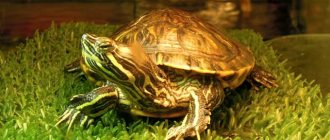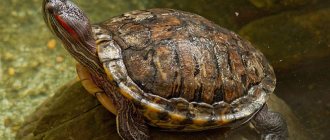- How long do turtles live?
Everyone associates turtles with the eternal slowness characteristic of these reptiles, but not everyone knows that turtles are one of the most ancient representatives of the animal world of our planet. These creatures have been living on Earth for more than 220 million years, yes, they are the same age as extinct dinosaurs. The very name of the word “turtle” comes from the ancient Slavic “shovel”, “tile”, and the Latin name for the turtle is similar – “testa” is translated as “tile”, obviously, the turtles were nicknamed this way due to the similarity of their shells with the tiles themselves.
Turtle: description, structure, characteristics. What does a turtle look like?
turtle shell
Perhaps it is the shell of a turtle that is its most characteristic difference, a kind of turtle calling card. For a turtle, it is, in fact, a sort of mobile home + a means of protection from enemies. The turtle shell consists of a dorsal (carapace) and abdominal (plastron) part. The carapace, in turn, consists of two parts, one of which is the internal armor, formed from bone plates, and the second is the outer part, consisting of horny scutes. In some species of turtles, the bony plates are covered with skin.
The shell of a turtle is very durable, so it can easily withstand a load exceeding the weight of the turtle itself by 200 times.
How big are turtles?
The size of a turtle and its weight differ greatly from the species, so in the turtle family there are both giant turtles with a weight of more than 900 kg and a shell size of 2.5 meters or more, and small turtles with a weight of up to 125 grams and a shell size no more than 10 cm.
Head and eyes of a turtle
The turtle's head is streamlined and medium in size. Such dimensions allow turtles, in case of danger, to quickly hide their heads inside an inaccessible shell. Although among them there are also species with large heads that either fit poorly in the shell or do not fit at all.
In land turtles, the eyes are usually directed towards the ground, while in aquatic turtles they are located closer to the top of the head and point forward and upward. The neck of many turtles is usually short.
The vision of turtles is well developed, even moreover, turtles, like people, have color vision and can distinguish colors, a gift that very few animals have. Nature also gave them excellent hearing, allowing them to hear potential enemies from a distance.
Does a turtle have teeth? How many teeth does a turtle have?
Modern turtles, unfortunately, do not have teeth, but ancient turtles had them, those that lived during the era of dinosaurs, but over time they disappeared. Then how does a turtle eat? To bite and grind food, turtles use a strong beak; the surface of this beak is covered with rough protuberances, which practically replace teeth for turtles. The tongue of turtles is short; it serves exclusively for swallowing food, but not for capturing it, and as a result, does not protrude outward.
Limbs and tails of turtles
All turtles, without exception, have four legs. But the very structure of these paws depends on the type and habitat of the turtle. The paws of land turtles have a flattened shape, they are adapted for digging soil and are quite powerful. In the process of millions of years of evolution, sea turtles' paws have turned into real flippers for the convenience of swimming in the depths of the sea.
Also, almost all turtles have a tail. The tail of a turtle, like its head, is also capable of hiding in its shell. Moreover, what is interesting is that some turtles have a real pointed spike at the tip of their tail, which serves as another means of protection from enemies.
An interesting fact: some land turtles can molt with age, and their old skin peels off and falls off, both from the paws and sometimes from the shell.
Features and habitat of the matamata turtle
This miracle grows to rather large parameters. Its length is 45-50 cm, its shell is up to 30 cm. Its weight is up to 15 kg. Her appearance is as unusual as it is terrifying.
The top of its shell is strewn with rough, compacted growths in the form of pyramids. On its upper part you can see three jagged keels. And its sides are decorated with clear notches. This reptile is like a tree trunk overgrown with moss.
Her rather large head is flat in shape. Due to thin leathery folds, it turns out triangular. In place of her nose, a real small proboscis is visible. This respiratory organ helps her breathe without raising her head out of the water.
On its lower part, the original processes in the form of a fringe are clearly visible; they perfectly help the reptile camouflage itself in water streams. Male matamata are distinguished from representatives of the opposite sex by their long and thin tails.
Their eyes are bulging and have sharp vision, which helps them see well in the dark. Her mouth is wide, stretching from one ear to the other. She doesn't have a neck like everyone else. She doesn't retract it, but twists it in both directions, like a lizard.
In case of possible danger, her head instantly disappears under cover. It becomes completely invisible to potential enemies. It also goes unnoticed because of its dark brown color, like water driftwood.
Its belly is green-yellow and brown. Looking at a photo of a matamata turtle, it is difficult to understand what it looks like in real life. The whole thing is covered with some kind of tubercles and the whole menacing appearance looks more like a boulder than a living creature.
Pictured is a Matamata turtle
People first heard about it from the German naturalist Johann Schneider. This was in 1783. The matamata's habitat is in southern African countries. Guinea, Peru, Venezuela, Bolivia, Brazil are the places where you can most realistically contemplate it.
Where does the matamata turtle live? She doesn't like stormy streams. They love rivers with a slow flow and stagnant water. They thrive on muddy swamp bottoms, on ponds and ancient river beds.
They don't like depth; they do better in shallow water. All freshwater inhabitants love silt. It is convenient to hide in it from potential enemies and sleep in hibernation.
They like waters with decomposed remains of vegetation and fauna, also called black waters, the most. They completely descend into these silty waters, exposing only their proboscis, with the help of which they obtain oxygen.
In addition to excellent vision, the matamata has perfect hearing and sense of touch. There are cells like this on her neck. With their help, the reptile accurately determines the movement of water flows, and therefore the movement of fish.
In general, the turtle likes to just lie on the bottom. She essentially lives without moving. Sometimes this even leads to the growth of algae on its neck and shell; they, together with the fringe, help the reptile remain unnoticed, both by its victims and by its enemies, and there are plenty of them in the Amazon.
It's interesting to watch how she pulls the victim into herself. The reptile's mouth opens with incredible speed, a stream of water, like in a funnel, it pulls the victim into it. After the victim gets into the mouth of the predator, she eats it, and releases the water back at the same incredible speed.
Matamata turtle behaves well in an aquarium
It is important that the room where it stands is always warm. At temperatures below 24 degrees, the already inactive matamata becomes passive and may refuse to eat
The temperature in her home should be about 28 degrees. She is the most heat-loving reptile.
The presence of special shelters in the matamata’s home is welcome; in them the reptile can hide from the light, which sometimes seems to irritate it. There should be a lot of free space in her home.
But the aquarium should not be deep. It is enough that the water slightly covers the animal’s shell. As for the quality of water, it must be within reasonable limits of PH balance. It is advisable to correct the slightest imbalance with the help of special preparations sold in pet stores.
The bottom of such an aquarium can be covered with ordinary sand, and marsh vegetation and underwater roots can be laid out along the edges. In all things steel, this is a rather unpretentious and lazy animal, which, being able to swim beautifully, prefers to lie motionless on the bottom.
How long do turtles live?
Turtles are truly long-lived even by our human standards, because they live many times longer than us humans. So the average life expectancy of turtles in natural conditions can be 180-250 years.
The oldest turtle in the world, named Jonathan, lives on the island of St. Helena and remembers (probably) the times of Napoleon, because the former emperor of France lived here in exile for some time.
Where do turtles live?
Turtles live in all tropical areas, as well as some places with temperate climates. Sea turtles swim in the warm ocean spaces of the Pacific, Atlantic and Indian Oceans. They are not found only near the Arctic and
Antarctica, which is natural, because all turtles love warmth.
Land turtles live in the steppes and semi-deserts of Africa, South and North America, Australia, and Asia. In Europe they can be found in the south, in a number of southern countries: Greece, Italy, Albania.
What do turtles eat in the wild?
The diet of turtles directly depends on their species, habitat and lifestyle. Land turtles are practically vegetarians; their main food is tree branches, fruits and grass, mushrooms and vegetables. However, it was not in vain that we wrote practically, since in order to maintain the protein balance in their bodies, turtles can sometimes eat various small animals such as snails, slugs and worms. Land turtles also drink water with pleasure.
But sea and freshwater turtles are already real predators, since their diet includes various small fish,
frogs, snails, crustaceans (some sea turtles happily eat squid, cuttlefish and other shrimp). But the gastronomic preferences of aquatic turtles are not limited to living creatures; along with them, they also eat plant foods: algae.
Interesting fact, there are species of sea turtles that eat poisonous jellyfish. From such food, the meat of the turtles themselves, in turn, becomes poisonous, which scares potential predators away from them. This is a gastronomic remedy.
Indonesia
The Indonesian Gili Islands are made up of three tiny islands. The islands are home to green turtles, which are vegetarian, and Hawksbill turtles, which are the most beautiful because of their colorful shells. The turtles are cared for under the protective eye of the island's Turtle Protection Center.
These tropical islands are good for divers, where you can dive approximately 10 meters below sea level. However, if you are not yet ready to dive, don't worry, you can snorkel with these beautiful species between March and September.
Enemies of turtles
Speaking of enemies, in natural conditions the main enemies of a turtle are some birds of prey (eagles,
hawks), which grab small turtles, lift them to a great height, from there they throw them onto stones and peck out their entrails from their broken shells.
Interesting fact: the great ancient Greek playwright Aeschylus died an extremely ridiculous death, he was killed by a turtle that fell on his head. The eagle, having lifted the turtle to a height, mistakenly considered the playwright's bald head to be a large stone suitable for breaking the turtle's shell.
Death of Aeschylus by an eagle and a turtle.
As for giant turtles, given their weight and size, they have no enemies in nature. Even people are increasingly treating these majestic, long-lived creatures with due respect.
Hibernation
If you don't know anything about this, then it's better not to try to style her. Only knowledgeable people should deal with this matter. Moreover, if you have created all the conditions necessary for a normal life, then hibernation is not necessary for your pet.
In the photo of domestic land turtles you can see what they look like before wintering. Typically, these reptiles huddle in a warm, dark corner and stick their heads forward. This occurs when the length of the day shortens, that is, in October.
If you decide to provide your turtle with winter rest, it is recommended to consult a veterinarian. Before hibernation, you need to carry out a number of procedures, namely: control your weight before and during wintering, completely empty your intestines of food, gradually reduce the temperature in the terrarium, etc.
When does a turtle hibernate?
Yes, turtles, like
Bears and some other animals tend to hibernate, during which all life processes in their body slow down for a while. This usually happens in winter, and hibernation for heat-loving turtles living in temperate latitudes allows them to survive the winter cold without problems.
How to determine the sex of a turtle
The gender difference in turtles is so weakly expressed in appearance that it is sometimes difficult to determine whether this turtle is a “boy” or a “girl.” However, if you approach this issue with due attention, you can identify a number of signs that help determine the sex of a turtle.
1. Shell; in females the shell has a more elongated shape than in males.
2. Plastron, also known as the lower part of the shell. If you turn the turtle over, you can see that in females the lower part of the shell (the one closest to the anus) is flat, while in males it is slightly concave.
3. Tail, males have a tail that is longer and wider at the base, while “lady turtles” have a straight and short tail.
4. Claws, in males they are usually longer on the forelimbs than in females.
Evolutionary history
All subspecies of elephant tortoises are descended from common ancestors that arrived from the mainland of South America by water. Their survival on the 1,000-kilometer journey across the ocean is due to the fact that turtles can swim and can breathe by raising their necks above the water. They are able to survive months without food or fresh water. Since turtles are poor swimmers, their journey may have been aided by the Peruvian Current, which moves west of the mainland towards the Galapagos Islands. It is assumed that the ancestors of the genus Chelonoidis must have been similarly distributed from Africa to South America during the Oligocene.
The closest living relative, although not a direct ancestor, of the Galapagos giant tortoises is the Argentine tortoise (Chelonoidis chilensis), with species from South America being much less closely related. Differences between Argentine and Galapagos tortoises likely occurred between 6 and 12 million years ago. This was an evolutionary event that preceded the formation of the modern Galapagos Islands by volcanism from the oldest 5 million years ago. Mitochondrial DNA analysis shows that the oldest existing islands (Hispaniola and San Cristobal) were colonized first, and then populations from them spread to the younger islands. Modern subspecies exhibit limited gene exchange between isolated islands as a result of independent evolution of populations into different forms. The evolutionary relationships between the subspecies thus follow the history of the volcanic islands.
Types of turtles, photos and names
The turtle family is divided into two suborders, divided by the way turtles retract their heads into their shells:
Also, according to their habitat, all turtles are divided into land and sea turtles, which in turn are divided into freshwater turtles, living in rivers and lakes, and marine turtles, living in the seas and oceans.
Below we take a closer look at some of the most interesting turtle species.
Galapagos tortoise
She's the same
elephant turtle. These are real giant tortoises, the weight of a Galapagos tortoise can exceed 400 kg, the length of the shell reaches up to 1.9 m. These tortoises live on the Galapagos Islands, which gave them their name.
Egyptian tortoise
This is already a small representative of land turtles, the length of the Egyptian tortoise shell is no more than 10 cm. They have a yellow-brown color of the shell. This turtle lives in northern Africa and the Middle East.
Central Asian tortoise
This is a small turtle that lives in Asia, has a rounded shell and is colored yellow-brown with dark spots. The average size of the shell of this turtle is 10 cm. It is also one of the most popular types of turtles for home keeping.
Leopard tortoise
She's the same
panther turtle. It is of medium size, the length of the shell is 0.7 m, with a weight of up to 50 kg. The shell of this turtle is high and dome-shaped. The pattern of the shell shows a spotted pattern, similar to the color of a leopard. The leopard tortoise lives in Africa.
Cape spotted turtle
It is notable for being the smallest turtle in the world. The length of its shell is no more than 10 cm, with a weight of up to 165 grams. Lives in South Africa.
Character and lifestyle
Even despite the insufficient level of brain development, as a result of testing it was possible to determine that the turtle’s intelligence shows fairly high results. It should be noted that not only land turtles, but also many freshwater species of turtles, including European marsh and Caspian turtles, took part in such experiments.
Turtles are reptiles that lead a solitary lifestyle, but such animals need the company of their own kind with the onset of the mating season . Sometimes turtles gather for the wintering period in not too numerous groups. Some freshwater species, including toad-headed turtles (Phrynops geoffroanus), are characterized by an aggressive reaction to the presence of their relatives, even outside the mating season.
Almost all existing species of turtles deservedly belong to the category of long-lived record holders among numerous vertebrates.
The well-known Radiant Tortoise of Madagascar, named Tui Malila, managed to live for almost two hundred years.
The age of such a reptile often exceeds a century. According to scientists, a turtle can live even two hundred years or more.
Types of freshwater turtles
Painted turtle
This small turtle lives in waters of the USA and Canada. It has an interesting olive-green or black shell color and leathery membranes between the toes.
European marsh turtle
This small turtle lives in the waters of Europe and a number of Asian countries; the length of its shell is 35 cm and its weight is 1.5 kg. It has a brown-brown or olive-colored shell, and also a very long tail, like for a turtle.
Pond slider
So named due to the presence of a bright red spot on the head. The length of the shell of this turtle is 30 cm. Red-eared turtles live in both Americas, in the USA, Mexico, Colombia, Venezuela and several other countries.
snapping turtle
Its characteristic feature is the presence of a cross-shaped plastron and a long tail covered with small spines. It is of medium size, the weight of this turtle reaches up to 30 kg. It lives in the USA and southern Canada; it survives the winter cold in hibernation.
Types of sea turtles
Hawksbill turtle
She's a real carriage. The shell of this turtle is painted in brown tones with a pattern of multi-colored spots. The front flippers of this turtle are equipped with two claws. This turtle lives in almost all oceans, with the exception of cold waters near the poles.
Leatherback turtle
Notable for being the largest turtle in the world. Only the span of its front flipper-like paws reaches 2.5 meters. Its weight is more than 900 kg, and its shell length exceeds 2.6 meters. The surface of this turtle's shell is covered with a dense layer of skin (hence the name). It lives in tropical regions of the Indian, Atlantic and Pacific oceans.
Green turtle
It is also a fairly large turtle, its weight reaches up to 450 kg with a shell length of 1.5 m. It has an olive or green shell color, which, however, may have white stripes and dark spots. Its shell is small in height and oval in shape, and its surface is covered with large horny scutes. The head of this turtle is much larger than that of other relatives, and therefore does not hide inside the shell. It lives in tropical areas of the Atlantic and Pacific oceans.
When did they appear
Scientists believe that turtles appeared on earth in the Triassic period of the Mesozoic era, i.e. approximately 200 million years ago. These were sea animals that had a rather large, serpentine neck and a large tail. They lived in the warm waters of the world's oceans, so we can say that the first turtles definitely came out of the water.
In the Cretaceous period of the same era, about 60-70 million years ago, Archelon appeared - one of the extinct ancestors, whose representatives already resembled turtles known today in shape and other features of appearance. It was a leatherback turtle with a soft shell. She lived exclusively in the seas of the world's oceans.
Known for its gigantic size and weight:
- fin span up to 5 meters;
- length up to 4.6 meters (from head to tip of tail);
- skull length up to 70 cm;
- weight more than 2 tons.
The remains of the archelon were found on the territory of modern USA; they are housed in various museums. There is a known exhibit from the Yale Museum - this archelon is missing a hind leg, which apparently was bitten off by a giant sea lizard mosasaurus, which reached a length of 12-14 meters.
Archelon
Large turtles that came from the Mesozoic era began to die off en masse relatively recently - in the current Quaternary period of the Kayonozoic, i.e. our geological era. This happened about 11 thousand years ago. Large animals gave way to smaller representatives.
Reproduction of turtles
The mating season for turtles occurs at different times depending on the species. However, in all turtles it occurs in a similar way: the males stage real battles for the right to mate with the female. How do turtles fight? It’s very simple, the land ones try to turn the enemy over with a blow from their shell, and the water ones hit and bite each other with their beaks. Only after driving away a potential rival does the male turtle begin courting his “lady,” forcing her to take a position convenient for the actual mating.
Some time after mating, the female turtle lays spherical or ellipsoidal eggs, from which small turtles will be born. Turtles dig special holes for their eggs, and sometimes even use the nests of crocodiles.
From 1 to 200 eggs can be laid at a time (depending on the species). Also, the duration of the incubation period can last from 2 months to six months or more.
After hatching, small turtles begin to struggle for survival; not all of them will survive to adulthood; young turtles are an excellent target for various predators, especially birds of prey.
Social structure and reproduction
Photo: Giant turtle from the Red Book
Giant tortoises reach sexual maturity between 20 and 25 years of age, and when the time is right, the male will mount the female and extend his long tail, which contains his penis, under her tail.
The underside of the male shell is convex, so it fits tightly to the rounded dome of the female and does not slip off.
Mating can occur at any time, but usually between February and June. Females travel several kilometers to nesting sites in dry, sandy coastal areas. Using her hind legs, she digs a deep cylindrical hole and lays her eggs. Dome-shaped females dig 2-3 nests per year, 20 eggs per nest. Saddleback females, living in harsher environments, dig 4 to 5 nests per year, averaging 6 eggs per clutch, to spread the risk. In each case, she retains the sperm from 1 copulation and uses it to fertilize several batches of eggs.
After 4-8 months, young individuals emerge from the eggs and dig them to the surface. They remain in warm, low-lying areas for the first 10-15 years. If they survive the initial dangers of extreme heat, crevasses, hungry sailors and Galapagos hawks, they are likely to live to old age.
How to care for a turtle at home
Keeping turtles at home has recently become very popular, both land and aquatic turtles are kept. And why not, because caring for them is extremely simple, and turtles themselves are unpretentious creatures. True, all of the above is true for small turtles, since keeping large turtles in the house will not be entirely appropriate.
So, what are the rules for caring for turtles? First, in the turtle's habitat, you need to keep a thermometer to monitor the air temperature and a thermometer to monitor the water temperature (if it is an aquatic turtle in an aquarium).
The water in an aquarium for turtles must either be purified using filters, or if there are none, then changed every day. Maintaining hygiene for aquatic turtles involves removing algae from their shells. But land turtles need to be bathed daily in warm water, washing away dirt and food debris. Also, in winter, it is advisable to irradiate turtles a little with the rays of a quartz lamp, thus creating a kind of sunbathing.
Costa Rica
Playa Grande – This beautiful beach is one of the best places in the world to see huge turtles all year round. The nesting season for tanners is from October to March, so visiting during this time means you may see small turtles heading towards the water.
Playa Grande is the second largest turtle nesting site. But it is necessary to order a guide so as not to disturb their nesting habits and so that the eggs are not damaged.
Most tours suggest visiting late in the evening, usually after sunset, to ensure the safety of the turtles, but don't worry as your guide will show you everything you need to know and lots of other interesting information.
What to feed a turtle at home
Turtles need to be provided with a balanced diet. Can you feed land turtles?
leaves of cabbage, dandelion, pulp of apples, cucumbers, tomatoes. To meet the need for protein food, they can be given boiled chicken eggs and vitamin supplements.
Feeding aquatic turtles will be a little more difficult, because they need small animals; you can feed them with dried daphnia, bloodworms, earthworms, boiled chicken or beef. They will not mind eating various insects, cockroaches, and small aquarium fish.
Adult turtles need to be fed once a day, young turtles twice a day and a so-called fasting day once a week.
Interesting facts about turtles
- It was turtles that were the first to fly around our moon, on board an experimental research probe launched by the Soviet Union back in 1968.
- Turtle meat is an expensive and delicious product in some cuisines around the world.
- Turtles are also present in heraldry, in the depiction of the coats of arms of some cities.
- Despite the fact that turtles do not pose a danger to humans, there are exceptions, for example, male leatherback turtles can confuse a swimmer with a female, grab them with their paws and drag them to the bottom.
- The sex of turtles in the egg is determined by the ambient temperature. At lower temperatures, males are born, at higher temperatures, females are born.
Economic importance
Not too large land and aquatic turtles are popular pets that are highly valued by exotic lovers. Turtle meat is widely used for food purposes and is consumed raw, boiled or fried, and the unpretentiousness of such animals makes it easier to transport live reptiles as “live canned food.” The animal's shell is used in the manufacture of such traditional women's hair ornaments as kanzashi.
Unlike many other well-known and studied reptiles, any turtle poses virtually no real threat to human life and health. The exception is represented by male leatherback turtles, who, with the onset of mating season, are able to grab swimmers with flippers or drown them, and biting and aggressive snapping turtles can inflict a serious bite on a person.
Video
https://youtube.com/watch?v=7IMiHx5eje0
https://youtube.com/watch?v=1dU3l007550
Sources
- https://ru.wikipedia.org/wiki/Turtleshttps://nashzeleniymir.ru/turtlehttps://simple-fauna.ru/reptiles/cherepahi/










